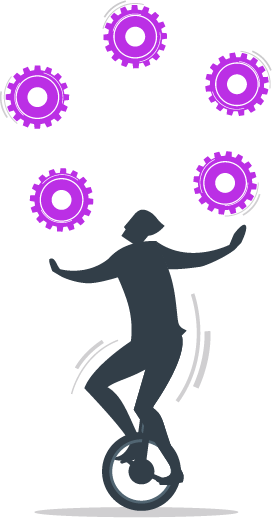eBook
The Build vs. Buy Debate
A Product Manager’s Guide to Software Monetization Systems
To Build or to Buy?
That is the question technology companies typically face when evaluating solutions for software licensing, entitlement management, and compliance.
If you develop your own products, it can be natural to assume everything should be coded in-house; from flashy features that customers crave to back-office infrastructure that makes everything tick.
After all, that’s why you employ your engineering team, right? They get paid to build things, so why invest in external platforms for backend operations?
However, while this approach may sound appealing, DIY is rarely straightforward, so it’s important to consider the benefits of purpose-built software monetization systems before making your decision.
DIY Scenarios
When relying on in-house resources to facilitate licensing, entitlements, and compliance, Product Managers generally take one of three routes:
- Leverage Existing Systems: Third-party applications such as Customer Relationship Management (CRM), Enterprise Resource Planning (ERP), or Identity and Access Management (IAM) tools can be used to partially track entitlements, but this often amounts to manual record keeping.
Advanced functionality – such as streamlining delivery of various pricing and packaging options based on subscription tiers – can be developed with customization, but you’ll always be reliant on engineers to hard-code updates, impacting your time-to-market. - Homegrown / Custom Code: Choosing to ‘go it alone’ allows you to create a system that is tailored to your specific needs, but it also means you’re responsible for ongoing maintenance and security, which is dependent on training the right people and ensuring they’re given sufficient time for continuous development.
Furthermore, homegrown solutions tend to be less flexible to new deployment and monetization models, such as consumption or outcome-based licensing, delaying your ability to innovate and adjust to market demands. - Do Nothing: Some suppliers simply opt for an ‘honor system’ whereby customers report usage levels (number of users, device installations, etc.), and periodically conduct on-site audits to verify results.
While there are obvious cost-savings associated with this approach, you’re also exposed to a significant risk of revenue leakage due to overuse (whether intentional or unintentional), and your ability to grow by offering flexible packages that allow customers to buy according to their needs (i.e., usage-based licensing, hybrid models, etc.) is severely restricted.
ENGINEERING CONSIDERATIONS FOR HOMEGROWN SOLUTIONS
How does it evolve over time?
- New licensing/monetization models
- New deployment models
- M&A integrations
- Ongoing development project – not just maintenance!
Costs
- Engineering time
- Hiring challenges – no company has unlimited head count
- Diverts investment from core product offerings
- Securing code against open-source threats is an ongoing commitment
“With Revenera, our development team could not have imagined working with a better partner; their support and resources exceeded expectations. The new F9 licensing solution was a real team effort, and our success is mutual.”
Play to Your Strengths
Ultimately, you want to maximize the talents of your team, empowering developers to focus on product enhancements rather than underlying mechanisms.
Award-winning restaurants keep their chefs in the kitchen, giving complete freedom to create dishes that entice customers to come back for more, with zero expectation to deliver food, collect payments, or watch out for ‘dine and dash’ violations.
Ideally, your business should function in a similar fashion, enabling engineers to concentrate on core competencies that drive recurring revenue rather than backend logistics that distract from product roadmaps.
With the right framework, operations should flow seamlessly, allowing you to accelerate time-to-market, increase customer retention, and boost your company valuation.
Benefits of Software Monetization Solutions
Implementing a commercial system can help you introduce new monetization models, reduce operational overhead, and tackle compliance issues as part of a comprehensive revenue optimization strategy. Here are some of the key advantages you can expect to leverage from specialized software monetization solutions:

Business Agility
- Automation: Commercial licensing and entitlement management systems typically enable a higher degree of automation, integrating with other business systems – such as your CRM and payment platform – to streamline the quote-to-cash process, reducing the need for manual interventions.
- Innovation: With usage-tracking capabilities, the opportunity to offer metered, consumption, or device-based monetization models can open new revenue streams, giving you a competitive edge with unique licensing and pricing packages that meet specific customer needs.
- Expansion: Purpose-built software licensing solutions are designed to scale with ease, making them suitable for suppliers that need to rapidly deliver large volumes of licenses on a flexible basis.

Revenue Generation
- Retention: Tracking usage highlights churn risk, flagging inactive users so you can proactively attempt to re-engage them ahead of renewal time, which is key to growing Annual Recurring Revenue (ARR).
- Conversion: By analyzing product usage data, you can detect piracy and collect unauthorized use reports to form targeted sales campaigns, delivering readymade infringement leads into your CRM, enabling you to convert piracy into profit.
- Precision: With usage insights, you’re also able to monitor overuse and misuse, checking whether license terms – such as installation limits or geographical restrictions – are being adhered to, allowing you to act where necessary.

Operational Efficiency
- Consolidation: By standardizing on a single licensing and entitlements platform across all product lines – including on-premises, SaaS, and hybrid deployments – you’ll create a unified customer experience and have a single source of truth for data-driven decision making.
- Evolution: If your growth strategy involves M&A activity, a purpose-built platform can adapt at speed, allowing you to easily integrate acquired products into your processes rather than manually stitching together information from multiple, disjointed systems.
- Satisfaction: A modern, centralized system enables self-service, allowing customers and channel partners to directly manage licenses and entitlements without assistance, resulting in fewer support tickets.
DIY or Collaboration?
Just because you produce software doesn’t mean you have to develop the licensing, entitlements, and compliance components in-house, much in the same way you wouldn’t build your own accounting or payroll system.
Getting these factors right is essential to the success of your business, so it pays to use proven technology that can manage every stage of the licensing lifecycle.
A dedicated platform frees resources to focus on revenue-generating initiatives rather than maintaining a homegrown system that relies on individual know-how, which can easily go undocumented – putting stability and scalability at risk.
To drive new and recurring revenue, you need a secure solution that allows you to swiftly respond to customer demands and competitive forces, accelerating your time-to-market with advanced pricing and packaging functionality and automatic update delivery.
A purpose-built system reduces your exposure to security vulnerabilities, safeguards against virtual machine cloning, and stops the accumulation of technical debt – effectively outsourcing your liabilities while you focus on product development.
You could try to build, maintain, and secure it yourself, but you have to weigh up whether your team has the required expertise, or if their time could be better spent elsewhere – especially when fully-formed alternatives are available.
“Revenera offered the out-of-the-box solutions and integrations we needed to support our business model. The transition from a hardware to software model was a learning process and we looked to Revenera for best practices. We’re benefiting from its experience in the industry as we continue to grow our business and do more with its software monetization platform.”
Software Monetization Consultancy
Developing flexible, feature-rich products with rapid release cycles is the ultimate key to growing your business, whereas tracking licenses and entitlements will never be a competitive differentiator – no matter how crucial they are.
Therefore, it’s wise to focus your resources where you’re going to see the biggest gain, building your customer-facing product rather than backend infrastructure.
With experience in protecting $40 billion in annual recurring revenue, and having helped recover $3.6 billion in lost revenue via Compliance Intelligence, our in-house experts have decades of industry experience and are happy to share practical advice.
If you’re in the process of considering which approach is best for you, our software monetization team is on-hand to answer any queries you may have, so please visit revenera.com and get in touch.
On average, Product Managers achieve the following results with Revenera Software Monetization
- 1-3% increase in renewal rates
- 1-5% improvement in channel performance
- 2-5% recovery in lost revenue (intentional and unintentional overuse)
- 5-15% savings in support tickets, with fewer escalations related to licensing
“Ikon Science is always looking to elevate our customer experience to provide the flexibility through license models and the release of new solutions with different delivery methods. Revenera has been a long-time partner to help us realize this vision by providing a variety of licensing models, remote connectivity options and allowing us to focus on technology innovation.”
Frequently Asked Questions (FAQs)
A software monetization system manages licensing, entitlements, and compliance for software products. It helps businesses control access, track usage, and optimize revenue streams. These systems can be built in-house or purchased as commercial solutions.
The decision depends on your company’s resources, expertise, and long-term goals. Building offers customization but requires ongoing maintenance, while buying provides proven features, faster deployment, and reduced risk. Evaluate your needs and growth plans before deciding.
Commercial solutions offer automation, scalability, and integration with other business systems. They reduce operational overhead, improve compliance, and enable new monetization models, helping you respond quickly to market demands.
Homegrown systems can be costly to maintain, less flexible to new models, and may expose your business to security vulnerabilities. They often divert engineering resources from core product development and can accumulate technical debt over time.
These platforms automate licensing processes, integrate with CRM and payment systems, and enable rapid adaptation to new pricing and packaging models. This agility helps businesses stay competitive and meet evolving customer needs.
Yes, by tracking usage and enforcing license terms, a robust system can detect overuse, misuse, and piracy. This allows you to address unauthorized activity and convert potential losses into revenue opportunities.
A single platform standardizes processes across all product lines, simplifies customer management, and provides a central source of truth for data-driven decisions. It also reduces support tickets by enabling customer self-service.
By monitoring usage and identifying churn risks, these systems enable proactive engagement with customers. This helps increase renewal rates and supports long-term revenue growth.
Key metrics include license utilization, renewal rates, revenue recovery from overuse, and support ticket volume. Monitoring these helps optimize performance and identify areas for improvement.
Begin by assessing your current licensing processes and business needs. Consult with industry experts, explore commercial platforms, and consider a pilot implementation to evaluate benefits before a full rollout.
Resources
Webinar
AI Monetization Unlocked: Master Pricing Models and Plan for Market Success
Tuesday, January 27, 2026
Join IDC's Tiffany McCormick, Research Director, AI Monetization, Pricing Strategies, and Business Models and Revenera's Paul Bland, VP, Product Management to learn pragmatic ways to align price with value—and avoid the cost‑plus trap.
Webinar
Revenera Connect 2026: Boston
Wednesday, February 11
Webinar
6 Steps to Launching Usage-Based Pricing for SaaS and AI
Tuesday, February 17, 2026
In this webinar, Nicole Segerer, General Manager at Revenera, will share this practical 6-step framework for launching usage-based pricing in SaaS, AI, and even on-premises products.
Report
Rethinking Pricing: How to Choose Models That Reflect AI-Era Value
This best practice report produced by Forrester provides an overview of pricing models, their pros and cons, and considerations for implementation.
Webinar
SoftSummit 2026
April 28, 29 & 30 (Tuesday, Wednesday & Thursday)
Report
Monetization Monitor: Software Piracy and License Compliance 2026 Outlook
Revenera’s latest research report examines emerging trends in the prevalence and scope of unlicensed software usage and demonstrates how leveraging usage analytics or compliance analytics can enhance revenue recognition opportunities.
Want to learn more?
See how Revenera's Software Monetization platform can help you take products to market fast, unlock the value of your IP and accelerate revenue growth.